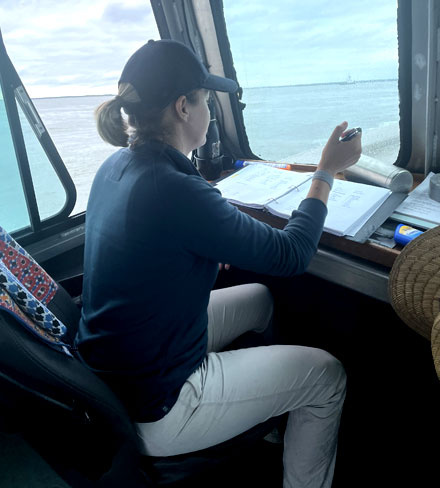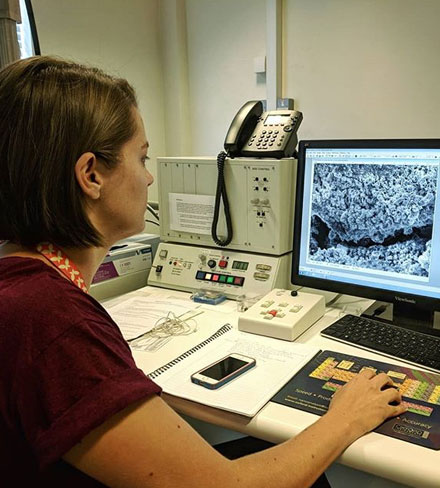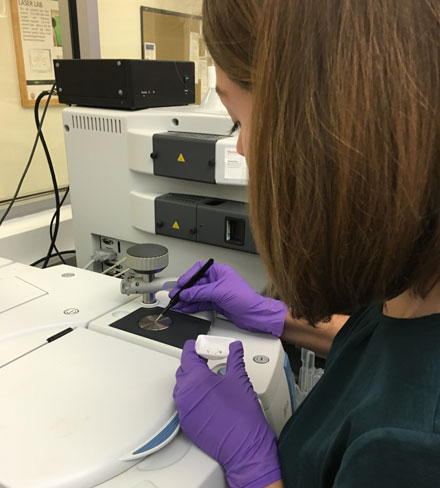





Kim Roche was an undergrad with plans for medical school when she decided to take a different turn. Completely in love with humanities, she started to look for career options that would combine chemistry and sciences with art history. And that’s when one of her undergraduate professors recommended looking into the field that many people don’t even know exists as a discipline – conservation.
“Once I had graduated undergrad, I started looking at internships in archaeological conservation because I knew I liked to work with archaeological material in particular and found that the Navy had an Underwater Archaeology Branch (UAB) that was hosting summer internships,” Roche says.
Living in Florida and loving the ocean, she couldn’t believe she had an opportunity to work in underwater archaeology. And couldn't imagine that it was a subdiscipline that she could specialize in.
After the initial excitement, she found out that it’s a very niche area meaning there are only a couple of universities around the world that offer programs in conservation. After completing her first internship with the Navy, Roche followed her passion to Florence, Italy and got a graduate certification in conservation from Studio Arts College International.
As she was looking ahead to doing her master’s in conservation practice at Cardiff University, she returned to UAB for her first NREIP internship in 2016. She remembers looking into a collection of wreck material from the Continental Navy schooner Royal Savage that had been recovered earlier in the 20th century and treated after recovery. These objects had a coating that was inhibiting preservation.
“The surface of the iron artifacts was actively deteriorating in front of your eyes – so you're losing original material from the object,” Roche says. “I completed assessments of the Royal Savage iron artifacts and was able to kind of characterize how much of the collection was affected by this, how big of a problem it was and how it impacted the stability.”
Supervised by UAB conservators, she identified the polymer coating, worked on a procedure and protocol to remove it, and tested different treatment methods before prescribing a plan. Through the working process, Roche found a special joy in chipping through different materials to get the object that was underneath. This fun aspect of the job not only required a unique skillset but took her back to her beginnings – art.
“You have to let the objects speak to you, not the other way around, you have to reveal what's already there essentially,” she explains.
Kim and UAB supervisors partnered with the Naval Academy and was able to use their analytical equipment to complete the analysis of the coating material. At the same time, Kim used to go out for a day or two with staff archaeologists to get their perspective on excavation and recovery and understand what efforts they had to go through. All of these were ‘incredibly useful and necessary” for someone who was just taking her first steps in the field.
With equipment in place and close cooperation among the members, the team was set for success. To not only solve a mystery and answer a research question but come up with a practical and feasible plan has served her well in that initial stage of her career.
“Being able to tailor recommendations is so important in our industry because you might be working at different institutions with different resources,” Kim said. “And sometimes one plan does not fit all museums or institutions that you're working for.”
Roche says NREIP gave her “a very rare and important opportunity” to train in a very focused field and be compensated for it, get lifelong connections and flush out her research interest.
After completing her internship, Roche went to Cardiff University where she got a master’s degree in conservation practice with a research focus on corrosion science. And then she landed a job at Clemson University’s Conservation Center in Charleston where she works as a conservator of archaeological material as well as historic and museum objects.
Roche describes it as a dream spot as she gets to do research, work with wreck material, and work on field projects, as well as work with industry partners such as local museums and various institutions – including collaborations with her former UAB colleagues.
She even gets to dive for work to get a consult on active projects. Last summer she got immersed in history and participated in a project exploring Housatonic – the first ship sunk in combat by a submarine when it was attacked and sunk by H.L. Hunley in Charleston Harbor.
“I would say military history runs right in line with that too. The artifacts and material culture we have from not just life on board of the vessel, but also the history of warfare and weaponry; of ship making itself,” she explains. “All of that is evidence that we can pull when we recover wreck material, as well as respecting them as a war grave.”
As Roche continues her work in Charleston, she also teaches iron corrosion, artifact conservation and recovery process as a guest lecturer. Similarly, to those very first days, she approaches her work with passion, excitement, and careful consideration.
“It's not just, you know, some inanimate object you're working on, but there are lives and a story and a mission attached to each object,” Roche explains. “And that gives your work some gravitas.”